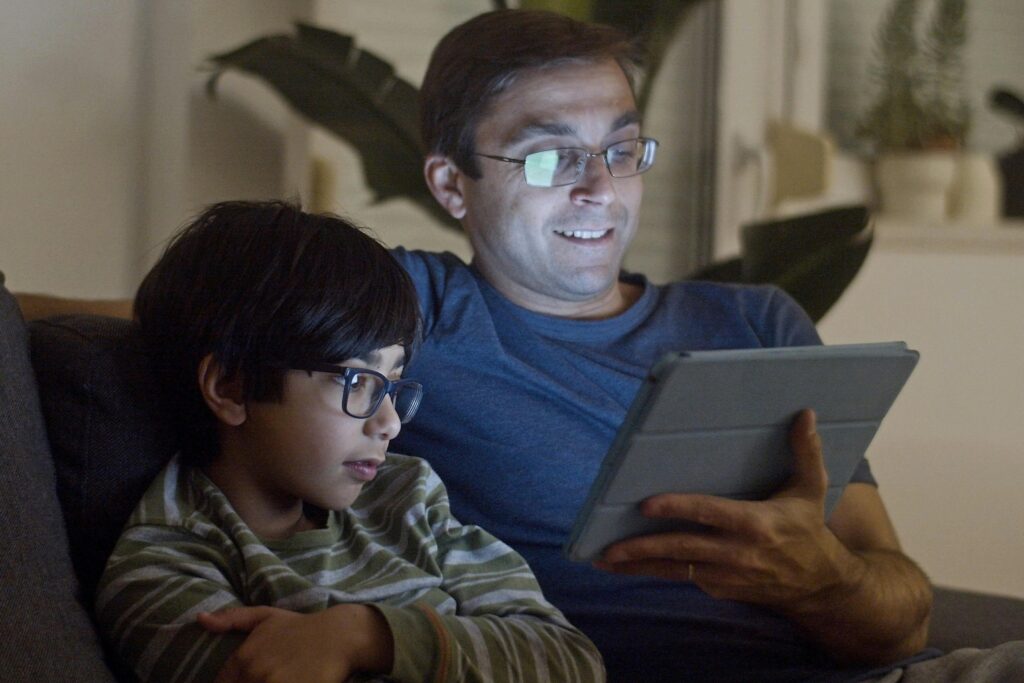Discover effective strategies to reduce your screen time and improve digital wellness. Learn practical tips for balancing technology use and enhancing your overall well-being.
Did you know the average American spends nearly 8 hours a day on digital screens? This is a big problem that shows we need to manage our screen time better. In this guide, you’ll find ways to cut down on screen time and boost your digital health.
Also see; Simple Steps for Screen Time Reduction: Reclaim Your Time and Balance
Also see; Screen time reduction strategies for mental wellness
By using the tips in this article, you can better control your screen use. You’ll learn to develop healthier tech habits and find a good balance between tech and well-being. Whether you want to use your phone less, avoid distractions, or enjoy more offline time, this guide has what you need.
This article will help you set goals, use digital wellness tools, and take back your time and focus. Let’s start exploring how to reduce screen time and live a healthier, tech-balanced life.
Screen Time Reduction: Why It Matters for Your Well-being
In today’s world, staring at screens for too long is a big worry for our health. Too much screen time can hurt our bodies, minds, and how we connect with others. It’s key to cut down on screen time.
Understanding the Impact of Excessive Screen Time
Too much screen time can cause eye strain, headaches, and mess up our sleep. The blue light from screens can also mess with our sleep hormone, making it hard to sleep well. This can make us tired during the day and hurt our focus.
The Benefits of Striking a Healthier Balance
Lowering your screen time can bring many good things to your life. These include:
- Improved sleep quality and better energy levels
- Increased focus and concentration, leading to enhanced productivity
- Reduced eye strain and headaches
- Improved mental health and reduced risk of anxiety and depression
- More opportunities for face-to-face social interactions and meaningful connections
- Increased time for physical activity, hobbies, and relaxation
Finding a balance between screen time and other activities is key for your well-being. It helps you stay healthy and feel good about your digital habits.
“Reducing your screen time can have a profound impact on your physical, mental, and social well-being, leading to improved sleep, enhanced productivity, and a greater sense of mindfulness.”
Identify Your Screen Time Usage Patterns
To take back control of your screen time, start by understanding how you use screens now. By watching and analyzing your daily screen activities, you can learn a lot. This knowledge will help you on your path to better digital health.
Begin by tracking your screen time on all devices like phones, tablets, laptops, and computers. Many devices and operating systems have tools to track screen time. You can also use apps that give detailed reports on app and website usage.
- Find out when you usually spend the most time on screens.
- See which apps or websites take up most of your time.
- Notice any patterns or triggers that make you use screens more, like boredom or social media alerts.
After you know your screen time habits, look for ways to cut down on unnecessary screen time. Try to do more activities that are meaningful and help you reach your goals.
“The first step towards change is awareness. The second step is acceptance.” – Nathaniel Branden
Knowing how you use screens helps you make better choices and manage your digital use better. This first step of self-reflection is key to a healthier relationship with technology.

Set Realistic Goals for Screen Time Reduction
To cut down on screen time, setting realistic goals is key. First, look at how much time you spend on screens. Then, decide on your ideal screen time limits. This helps you find a better balance between digital life and real life.
Determining Your Ideal Screen Time Limits
Start by checking how much time you spend on screens. This includes social media, entertainment, work, or talking to others. Think about what’s important to you and your lifestyle. Set limits that let you stay productive and take care of your health.
Prioritizing Essential Screen Activities
- Find out which screen tasks are really important for work, school, or personal stuff.
- Set aside specific times for these important tasks. This helps you focus and avoid distractions.
- Try to be aware of your screen time. Limit time spent on things that aren’t essential.
By setting realistic goals and focusing on what’s important, you can improve your relationship with technology. Remember, making small changes can lead to big improvements in your digital health over time.

“The key to a balanced life is not to prioritize your schedule, but to schedule your priorities.” – Stephen Covey
Implement Strategies for Mindful Screen Use
Learning to use screens mindfully is key to a healthier digital life. By setting up screen-free zones and times, you can take back control. This helps you stay present and focused every day.
Establishing Screen-Free Zones and Times
Make some areas in your home and office tech-free. Think about making your bedroom, dining room, or other spots screen-free. These areas can be places where you relax and recharge without digital distractions.
Also, setting aside screen-free times is very helpful. You might choose to not use screens during meals, in the evenings, or for certain activities. This way, you can enjoy quality time with others or take care of yourself without screens.
- Designate screen-free zones in your home and office
- Establish consistent screen-free times, such as during meals or in the evenings
- Explore mindful alternatives to screen use, such as reading, journaling, or engaging in hobbies
“The greatest weapon against stress is our ability to choose one thought over another.” – William James
By making these changes, you can use screens more mindfully. This leads to a healthier and more balanced relationship with technology.

Leverage Digital Wellness Tools and Apps
In today’s digital world, many tools and apps help us control our screen time. They are great for tracking how much time we spend on devices. This lets us manage our digital habits better.
Exploring Screen Time Tracking Apps
Screen time tracking apps give us a detailed look at how we use our devices. They show how much time we spend on certain apps and how often we unlock our phones. Knowing this helps us find ways to use technology less.
Utilizing App Limits and Restrictions
Many devices and operating systems have features to limit app use. These tools let us set time limits for apps each day or week. We can also block distracting apps or set times when we can’t use screens.
| Digital Wellness Tool | Key Features | Compatibility |
|---|---|---|
| Screen Time (iOS) | – Track daily and weekly screen time – Set app limits and downtime – Restrict access to certain apps | iOS devices |
| Digital Wellbeing (Android) | – Monitor app usage and app timers – Set daily limits and wind down schedules – Silence notifications during set periods | Android devices |
| Freedom | – Block distracting websites and apps – Schedule internet/app blocking sessions – Customize blocking rules and exceptions | Windows, macOS, iOS, Android |
Using these digital wellness tools and apps helps us manage our screen time and reduce unnecessary technology use. They help us keep a healthy balance with our devices.
Screen Time Reduction: Tips for Managing Distractions
Notifications and alerts can make it hard to cut down on screen time. They can get in the way of your goals for less digital use and a healthier life. Here are some tips to help you stay focused and meet your screen time goals.
Minimizing Notifications and Alerts
One key way to fight distractions is to cut down on notifications and alerts. These constant interruptions can make it hard to focus and might make you use your screens more than you should.
- Turn off notifications for non-essential apps: Look at the apps on your devices and turn off notifications for apps you don’t need every day.
- Customize notification settings: Change your device’s notification settings so you only get alerts for the most important things.
- Implement “Do Not Disturb” modes: Use your device’s “Do Not Disturb” feature to block alerts during work hours or when you’re relaxing.
- Batch and schedule notifications: Get your notifications all at once instead of right away. This lets you deal with them in a focused way.
By taking steps to reduce notifications and alerts, you can make your environment more peaceful. This helps you stay focused and promotes better screen habits.
“The greatest weapon against stress is our ability to choose one thought over another.” – William James
| Approach | Benefits | Considerations |
|---|---|---|
| Turn off non-essential notifications | Reduces distractions and interruptions | Ensures you only receive critical alerts |
| Customize notification settings | Allows for a personalized level of control | Requires time to configure settings |
| Implement “Do Not Disturb” modes | Provides uninterrupted focused time | May need to allow exceptions for important contacts |
| Batch and schedule notifications | Promotes a more organized and efficient approach | Requires discipline to avoid checking notifications constantly |
By using these strategies to reduce notifications and alerts, you can fight distractions. This is a big step towards managing your screen time and living a healthier digital life.
Cultivate Healthy Habits and Alternatives
To cut down on screen time, find better things to do. Try physical activities, new hobbies, and mindfulness. These can make you less dependent on tech and improve your health.
Engaging in Physical Activities and Hobbies
Doing physical activities every day is a great way to cut screen time. You could walk fast, play sports, or try a new exercise class. It keeps you active and full of energy.
Try hobbies that don’t need screens, like gardening, painting, or playing music. They offer a nice break from screens.
Practicing Mindfulness and Relaxation Techniques
Mindfulness and relaxation can help you use less screen time. Try meditation, yoga, or deep breathing to manage stress and focus better. These activities can replace scrolling or watching too much TV.
“Replacing screen-based activities with healthier alternatives is crucial for achieving sustainable screen time reduction.”
By doing physical activities, hobbies, and mindfulness, you can use screens less. This balanced approach to digital life improves your mental, physical, and emotional health. It helps you live a more fulfilling and connected life.
Involve Family and Friends in Your Digital Wellness Journey
Getting your family and friends to help you cut down on screen time can really help. It makes you more accountable and keeps you motivated. Working together, you can all aim for a better digital balance.
Talk openly with your family and friends about your goals. Explain why cutting down on screen time is important. Ask them to join you, as their support is key to your success.
- Encourage family members to set their own screen time limits and create screen-free zones in your home.
- Propose regular family or group activities that don’t involve screens, such as outdoor adventures, board games, or crafting sessions.
- Challenge your friends to a friendly competition to reduce screen time, and celebrate your collective progress.
With your loved ones on board, you can all stay on track and find fun ways to manage screen time. This team effort makes your journey more fun and lasting.
| Involve Family | Involve Friends |
|---|---|
| Set screen-free zones and times together | Challenge each other to reduce screen time |
| Participate in screen-free activities | Celebrate progress and milestones |
| Hold each other accountable | Provide mutual support and encouragement |
By taking your digital wellness journey with your family and friends, you can find a better balance. This benefits everyone and leads to a healthier lifestyle.
Conclusion: Embracing a Balanced Approach to Screen Time
As you’ve learned, finding a balance with screen time is key for your well-being. By using the strategies shared, you can cut down on screen time. This helps you develop better tech habits and improve your digital health.
It’s all about finding a balance between tech use and other life aspects. This means managing your screen time well, avoiding distractions, and finding new ways to engage. These can make your life richer in many ways.
Take a mindful approach to your digital life. Use technology wisely while keeping a healthy view. By focusing on balanced screen time, you’ll see better productivity, mental health, and more presence in your life. Start this journey towards wellness through tech balance and enjoy a healthy, sustainable relationship with digital devices.
FAQ
What is the importance of reducing screen time for your well-being?
Too much screen time can harm your health. It can affect your sleep, productivity, and mental state. Cutting down on screen time can improve your life balance and overall health.
How can I identify my current screen time usage patterns?
Start by tracking how much time you spend on screens. This helps you see where you can cut back. It’s the first step to reducing your screen time.
What are some effective strategies for setting realistic goals for screen time reduction?
To set good goals, figure out how much screen time you want. Then, focus on the screen activities that are really important. This way, you use technology wisely.
How can I implement mindful screen use practices?
Being mindful with your screen use is key. Create screen-free areas and times in your day. This helps you use technology more thoughtfully.
What digital wellness tools and apps can I use to manage my screen time?
There are many tools and apps to help you control your screen time. They track your use and set limits. These tools give you insights and control over your tech use.
How can I manage distractions from notifications and alerts to reduce screen time?
Cutting down on notifications helps you focus less on screens. By managing these distractions, you can stay on track with your goals.
What healthy habits and alternatives can I adopt to reduce my screen time?
Replace screen time with better activities. Try physical activities, hobbies, or mindfulness. These can help you reduce screen time and improve your well-being.
How can I involve my family and friends in my digital wellness journey?
Getting your family and friends involved can help you stay on track. It creates a supportive environment for lasting change.



